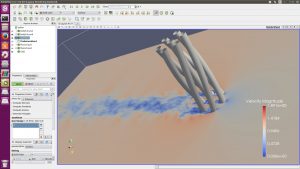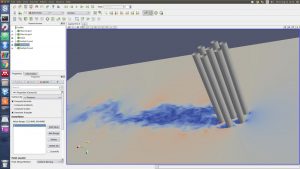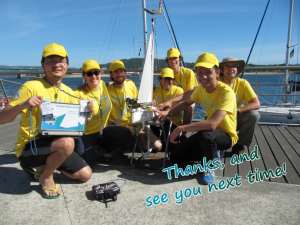This summer one of our recent MEng graduates Carlos Losada de la Lastra spent a month in Southampton and two in Singapore and reports on his research project in offshore hydrodynamics.

The offshore industry is tending towards multi-riser structures where the offshore platform or floating unit uses more than one pipe to meet more requirements. These pipes have a cylindrical cross section, which may induce vortex induced vibrations (VIV) as crossflow passes around them. This causes fatigue and high loading on the connection points at the seabed and the offshore structure.
The aim of the study was to investigate whether a helical arrangement of the cylinders could reduce the vibrations of the array and provide a wider operational window for offshore structures with multiple risers. I carried out the study using Assoc. Prof. Weymouth’s CFD solver, Lotus, to predict the flow around a seven cylinder array. The main parameters affecting the VIV of the array are, the flow speed, the gap between the cylinders, and the pitch of the array. Where the pitch governs the helicity of the array. To decouple each of the parameters I carried out separate investigations covering each of the parameters.

I started the parameter investigation by looking into the effects the gap had on the side force produced by the vortex shedding. I then started investigating the effects of varying the flow speed on the gap range of relevance. Before running simulations of the helical array I had to write a mapping function that twisted it. Having finished writing and validating the mapping function, I looked into the effects of varying the pitch of the array.
The project has been a really good experience. The idea of a helical array came from a question I asked during a lecture last January. This really motivated me throughout the project. The project itself provided a great insight to research. My two supervisors, Assoc Prof. Weymouth and Dr. Vinh Tan, provided invaluable guidance and help throughout the project, but it was up to me to run the simulations, deliver good results and contribute to the discussion. This allowed me both to develop and organise, my simulations, my thought process and my reasoning through the concepts. I learned a lot about hydrodynamics, running and automating simulations, and post processing of results. I also improved my programming and computing skills.

On the cultural side of things I managed to see and experience Singapore with many friends, and squeeze a trip to Bangkok on a weekend as a back packer.



